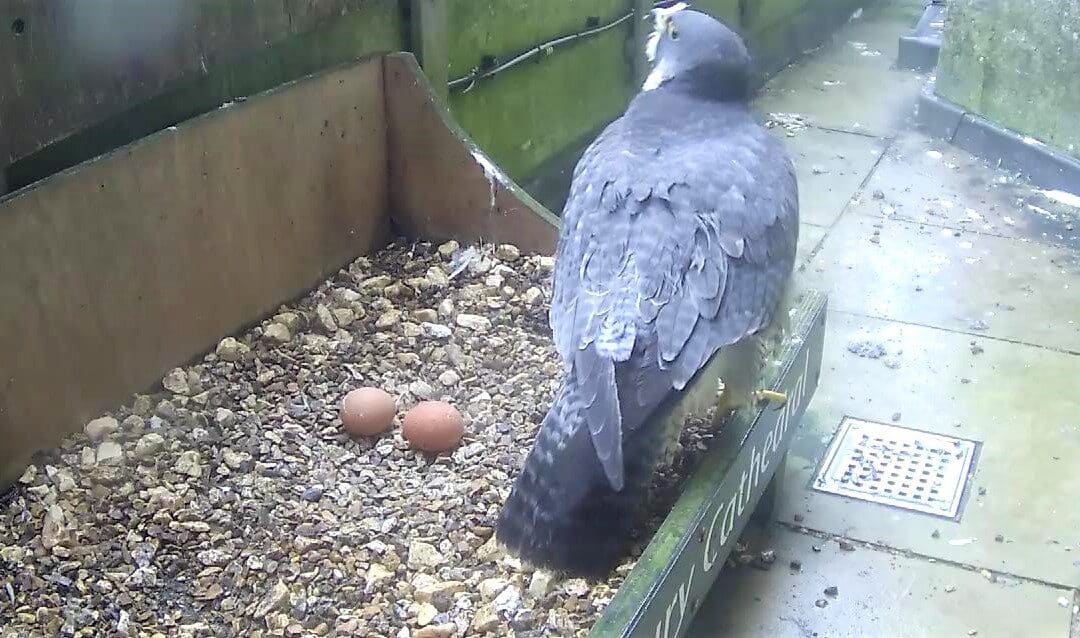The Salisbury Cathedral peregrines planned livestream launch date was Friday, March 17, at about 6.45pm for the first egg, and the second egg followed at around 01.19am on March 21. Will there be four again this year?
The nesting pair can be watched via three cameras sited on the South Tower balcony; two are set up to catch the action on the nestbox, and one at the other end of the balcony, which has been dubbed the ‘larder’ as it is where the adult peregrines often store spare food. https://www.salisburycathedral.org.uk/discover/peregrine-falcons/peregrine-live-webcam/
The Peregrine Facebook Group admits new members to share stories and footage. https://www.facebook.com/groups/salisburycathperegrinegroup – and experts Phil Sheldrake and Granville Pictor are on hand to help answer any questions. Granville will also be blogging again this year.
Granville Pictor from the Wiltshire Ornithological Society and the Cathedral’s peregrine expert said:
“The Cathedral’s cameras offer us a fascinating insight into the lives of these amazing raptors and a chance to study their behaviour. For example, this female probably won’t start incubating until she lays her next-to-last egg – they generally lay between three and four – so we’ll see the eggs left uncovered for longish periods. She’ll instinctively know when to settle down, and then we’ll see everything unfold.”
Phil Sheldrake, Senior Advisor at Natural England and Nature Advisor to the Cathedral, who instigated the peregrine project when he was working as a conservation officer at the RSPB, said:
“It is good to see the peregrines back and laying. Being able to watch the breeding process like this is a great way of involving people in wildlife conservation and the natural world – and it’s great to see that the Cathedral is extending its environmental programme to include wildflower planting, a giant bug Cathedral, bat and bird boxes and the Queens Green Canopy trees planted on Marsh Close. Every little bit helps and encourages others to do the same.”
To date, 27 peregrine chicks have fledged from the Tower, and thanks to their colour rings (or Darvic rings), have been tracking:
Osmund (blue colour ring YK) was spotted in Guernsey in April last year
Flo (orange colour ring TND) in Hertford in September last year
Peter (blue colour ring GX) was spotted with a mate in Hampshire and has raised his own chicks
Aveline (blue colour ring SC) in Milton Keynes in January 2017.
Have you spotted one of the falcons? – Check the letters on the colour ring on their left leg. Salisbury peregrines from 2014-2020 have a blue ring; peregrines after 2021 carry orange rings.
The adult peregrines currently nesting on the South Tower balcony have been visiting the site regularly over winter and were caught earlier this month engaging in courtship behaviour such as bowing (when the male ‘bows’ to the female, lifting his tail and keeping his head down) and scraping (when the birds dig out the nestbox gravel with their feet to create a dip), with some spectacular courtship flights up and around the Spire.
Now that eggs have been laid, Cathedral Close visitors may still see both peregrines out and about for a while, but once the female starts to incubate the eggs, the adults will take in turns to sit on them, so you’ll only ever see one at a time. The nestbox action is also relayed to a screen in the West Cloister.
Salisbury Cathedral has a historical bond with peregrines, which was broken in the twentieth century because of persecution and pesticides. There were nine fully authenticated sightings between 1864 and 1953, details of which are held in the Wiltshire archive. However, a long period of absence followed, from 1953 until 2014, when a pair bred successfully on the South side Tower balcony. Three peregrine chicks were hatched, ringed and fledged from the base of Salisbury Cathedral’s Spire that year and a further four in 2015. In 2016 two peregrines out of a clutch of four survived and fledged, and in 2017 only one chick hatched but was joined by an orphaned chick after a few weeks. Both birds successfully fledged. There were no chicks on the Tower in 2018 after Sally lost her mate, but a new pair moved in in 2019 and that year and the following year successfully fledged four chicks. Last year saw four chicks successfully fledge, bringing the total number of chicks hatched on the Tower to 22, plus our orphan, adopted in 2017.
Names and Rings: Every year, chicks hatched on the Tower are ringed to allow them to be tracked and traced – and they are traditionally named at the same time. Until 2020 each chick was given a blue identification ring with unique initials, but in 2021 the ring colour changed to orange. Details of names and calls are below.
The good news is that all three cameras are now streaming and can be viewed here:
https://www.salisburycathedral.org.uk/discover/peregrine-falcons/peregrine-live-webcam/




